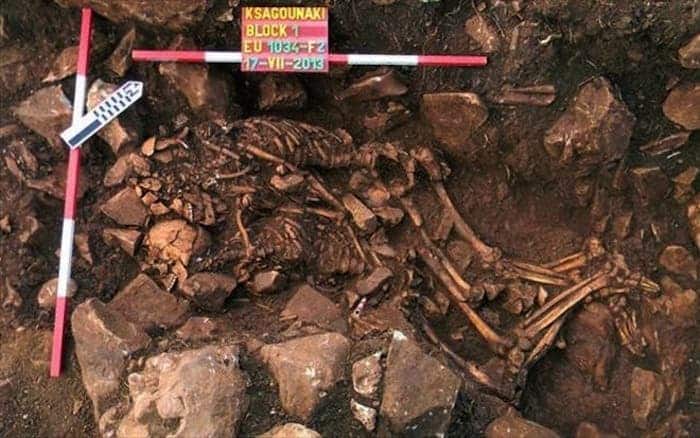A rare Neolithic-era burial site was discovered by the northern entrance of the Alepotrypa (“Foxhole”) Cave in southern Greece. The skeleton remains show how a couple was laid to rest in embrace, close to a burial of another male and female who were found in fetal position – the most common burial position during the Neolithic. The embracing couple’s skeletons were dated with the C14 method to 3800 BC while their DNA analysis confirmed the remains were those of a male and female.
Till death do us apart

The findings were unearthed in one of the most important Neolithic cemeteries, found in the greater area of the Neolithic Diros Cave, in western Mani, where excavations have yielded children, embryo and adult burials dated from 4200 to 3800 BC. According to archaeological findings, the cave was used as both settlement and cemetery from Early to Final Neolithic (6000-3200 BC). During its final years at a settlement, a great earthquake sealed the entrance of the cave and the remains of its inhabitants inside for eons. It wasn’t until 1958 when speleologists Yiannis and Anna Petrocheilos discovered the sealed entrance to the cave that this long lost Neolithic community surfaced back in collective consciousness.
Excavations following the discovery immediately started and continue to this day. Dr. George Papathanassopoulos is head of the excavations efforts and one of the researchers who reported the grave of the embracing couple – a rarity among neolithic graves. The fact that an ossuary and several ceramic urns, beads and other offerings were found in the grave points to “an organized society,” he said.
“The type of burial in fetal position is common in the Neolithic era, but the specific double burial in embrace is one of the earliest known examples. At some point, they will be exhibited in the museum following its extension,” he said.
This might be the earliest Neolithic couple to be buried together. Elsewhere, in Italy, archaeologists discovered in 2011 the remains of a couple buried 5,000 to 6,000 years ago, their arms still wrapped around each other in an enduring embrace. Italians dubbed them the “Lovers of Valdaro” after the Mantova suburb of farmland and factories.
The world’s first evidence of a human ritual burial is the Mungo Man, dated 40,000 years old and found in Australia. Being the oldest human remains in Australia, the Mungo Man provides an insight into early expansion and adaptation of modern humans, Homo sapiens, to the deteriorating climate of the world’s driest inhabited continent. As far as funeral decorations are concerned, humans have been decorating graves with flowers for almost 14,000 years.
Was this helpful?



